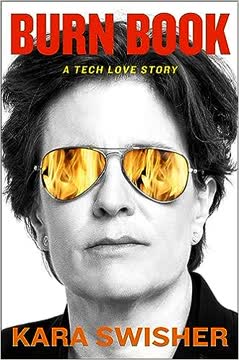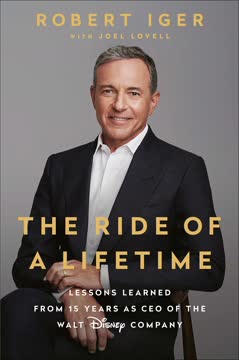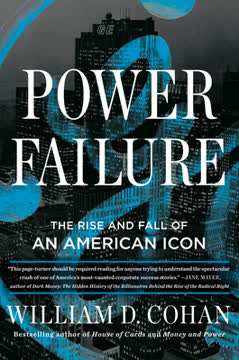Key Takeaways
1. Michael Eisner's rise to power at Disney and his transformative leadership
"Eisner had not only saved Disney, he had transformed it into the world's leading entertainment company and protected its beloved brand name."
A struggling company revitalized. When Michael Eisner arrived at Disney in 1984, the company was faltering, with its studio and animation division moribund and its assets coveted by corporate raiders. Eisner, along with Frank Wells, embarked on a mission to save and transform the company.
Strategic vision and execution. Eisner's approach combined:
- Revitalizing the animation division
- Expanding into new markets and media
- Modernizing the theme parks
- Aggressive cost-cutting measures
- Leveraging the Disney brand across multiple platforms
Financial turnaround. Under Eisner's leadership, Disney experienced:
- A tenfold increase in market capitalization from $2 billion to $22 billion in just eight years
- Record profits and revenues across multiple divisions
- A renewed reputation as a creative powerhouse in Hollywood
2. The Katzenberg-Eisner partnership: A creative powerhouse with growing tensions
"Katzenberg saw Eisner as a mentor and confidant, though the two almost never socialized."
A dynamic duo. Jeffrey Katzenberg joined Disney alongside Eisner, bringing his prodigious energy and work ethic to the studio. Their partnership was initially highly successful, with Katzenberg overseeing a string of hit live-action films and spearheading the animation renaissance.
Growing tensions. Despite their professional success, the relationship between Eisner and Katzenberg became increasingly strained due to:
- Katzenberg's ambition and desire for recognition
- Eisner's reluctance to share credit and power
- Disagreements over creative and business decisions
- Personality clashes and communication breakdowns
The breaking point. The death of Frank Wells in 1994 brought the Eisner-Katzenberg conflict to a head, ultimately leading to Katzenberg's departure from Disney and the formation of DreamWorks SKG.
3. Disney's animation renaissance: From near-extinction to global dominance
"In Little Mermaid, Beauty and the Beast, and Aladdin, Disney seemed to have conjured up the magic it so often talked about, producing deeply moving, critically acclaimed yet accessible films likely to become enduring classics."
Reviving a dying art form. When Eisner and his team arrived at Disney, the animation division was on the brink of extinction. Through a combination of strategic decisions and creative talent, they orchestrated a remarkable turnaround:
- Investing in new technology (CAPS computer animation system)
- Recruiting fresh talent and revitalizing the creative process
- Embracing Broadway-style musical elements in animated features
A string of blockbusters. Disney's animation renaissance produced a series of critical and commercial hits:
- The Little Mermaid (1989)
- Beauty and the Beast (1991)
- Aladdin (1992)
- The Lion King (1994)
Cultural and financial impact. These animated features not only dominated the box office but also:
- Revitalized Disney's merchandising and licensing businesses
- Spawned successful Broadway adaptations
- Cemented Disney's position as the leader in family entertainment
- Generated billions in revenue across multiple platforms
4. Eisner's strategic acquisitions and expansion of Disney's empire
"By the time he got back to his office, Eisner's feelings of relief were giving way to guilt about the way he'd treated Katzenberg. He realized he'd snubbed him, that he'd not had the courage to explain his decision to him face-to-face."
Building a media conglomerate. Eisner recognized the need for Disney to expand beyond its traditional business lines to remain competitive in the evolving media landscape. Key acquisitions and strategies included:
- The purchase of Capital Cities/ABC for $19 billion in 1995
- Expansion of the theme park business, including Euro Disney
- Growth of the Disney Stores retail chain
- Development of new content distribution channels
Challenges and controversies. While many of Eisner's expansion efforts were successful, some faced significant hurdles:
- Euro Disney's financial struggles and cultural backlash
- The abandoned Disney's America theme park project
- Integration challenges with newly acquired businesses
Long-term impact. Despite some setbacks, Eisner's expansion strategy laid the groundwork for Disney's transformation into a global media powerhouse, diversifying its revenue streams and expanding its reach across multiple platforms and markets.
5. The fall of Frank Wells and the subsequent power struggle
"Frank Wells had been killed in a helicopter crash returning from skiing in a remote area in the Nevada mountains. Only one passenger had survived."
A devastating loss. Frank Wells' death in 1994 was a significant blow to Disney's leadership team. As president and COO, Wells had been:
- A stabilizing force in the company
- A mediator between Eisner and other executives
- A key contributor to Disney's financial success
Power vacuum. Wells' absence created a leadership void that led to:
- Increased tension between Eisner and Katzenberg
- A reshuffling of executive responsibilities
- Uncertainty about the company's future direction
Eisner's response. In the wake of Wells' death, Eisner:
- Initially assumed Wells' titles and responsibilities
- Resisted promoting Katzenberg to president
- Eventually recruited Michael Ovitz as president, leading to further turmoil
6. Ovitz's tumultuous tenure: A Hollywood power player's corporate misfit
"Ovitz knew immediately that he was facing his first major crisis at Disney. Though not sophisticated about matters of corporate management, he knew that to be stripped of legal and financial responsibilities meant he was not really a chief operating officer, and that it left him dangerously bereft of any management authority."
A high-profile hire. Michael Ovitz, known as "the most powerful man in Hollywood," joined Disney as president in 1995, generating excitement and high expectations.
Cultural clash. Ovitz's transition from talent agency to corporate executive was fraught with challenges:
- Resistance from existing Disney executives
- Difficulty adapting to corporate culture and decision-making processes
- Conflicts with Eisner over management style and authority
Failed initiatives. Ovitz's attempts to make his mark at Disney were largely unsuccessful:
- Proposed deals and acquisitions were frequently rejected
- Efforts to reshape Disney's music and publishing businesses were thwarted
- His management style alienated many within the company
Short-lived tenure. Ovitz's time at Disney lasted only 14 months, ending in a high-profile dismissal that would lead to years of litigation and controversy.
7. Eisner's management style: Visionary leadership marred by personal conflicts
"Eisner was not so insensitive as to fail to realize how disappointed Litvack was likely to be at the prospect of Ovitz becoming president. 'He was conflicted,' Eisner later said of Litvack. 'He didn't criticize so much the selection of Ovitz per se…. But he did criticize the need to bring in anybody because it was quote unquote 'going so well.'"
Creative vision. Eisner's leadership was characterized by:
- A strong emphasis on storytelling and creative content
- The ability to spot and nurture talent
- A keen understanding of popular culture and consumer tastes
Strategic acumen. Eisner demonstrated:
- A talent for identifying lucrative business opportunities
- The ability to negotiate complex deals and acquisitions
- A focus on synergy across Disney's various divisions
Personal conflicts. However, Eisner's management style was also marked by:
- A tendency to micromanage and interfere in creative decisions
- Difficulty sharing credit and power with other executives
- Personal grudges and feuds that sometimes influenced business decisions
Legacy. Eisner's tenure at Disney was ultimately a mix of tremendous successes and significant controversies, leaving a complex legacy that continues to be debated in the entertainment industry.
Last updated:
FAQ
What's DisneyWar about?
- Corporate Drama: DisneyWar by James B. Stewart chronicles the tumultuous years of the Walt Disney Company under CEO Michael Eisner, focusing on internal conflicts, power struggles, and strategic decisions.
- Key Figures: The book highlights significant personalities like Michael Eisner, Roy E. Disney, and Jeffrey Katzenberg, exploring their relationships and the impact of their decisions on Disney's trajectory.
- Themes of Power and Control: It delves into themes of corporate governance, the clash between creativity and profitability, and the challenges of maintaining a legacy brand in a rapidly changing entertainment landscape.
Why should I read DisneyWar?
- Insight into Corporate Culture: The book provides a deep dive into the corporate culture of one of the most iconic companies, revealing the complexities of leadership and management.
- Lessons on Leadership: Readers can learn valuable lessons about leadership styles, decision-making, and the impact of personal relationships in a corporate setting.
- Engaging Narrative: James B. Stewart's storytelling combines thorough research with compelling anecdotes, making it an engaging read for both business enthusiasts and Disney fans.
What are the key takeaways of DisneyWar?
- Power Struggles: The book illustrates how power struggles, particularly between Eisner and Katzenberg, can impact a company's direction and morale.
- Importance of Creativity: It emphasizes the necessity of balancing creative vision with financial realities, showcasing how Disney's success hinged on its ability to innovate while managing costs.
- Legacy Matters: The narrative underscores the significance of legacy in corporate governance, particularly how the Disney family’s influence shaped decisions and strategies.
What are the best quotes from DisneyWar and what do they mean?
- “You’re making an awful mistake.”: This quote from Roy E. Disney reflects his frustration with the board's decision to push him out, highlighting the tension between family legacy and corporate governance.
- “We have to get out of this deal.”: Eisner’s insistence on terminating the Marriott partnership illustrates his commitment to maintaining Disney’s creative integrity over financial expediency.
- “You have compromised your soul and lost your integrity.”: Stanley Gold's statement during a shareholder meeting encapsulates the disillusionment with Eisner's leadership, emphasizing ethical governance.
How does DisneyWar depict Michael Eisner's leadership style?
- Centralized Control: Eisner is depicted as a leader who centralized power, often making unilateral decisions without consulting his team, leading to a culture of fear and compliance.
- Charismatic but Flawed: While Eisner's charisma and vision initially drove Disney's success, his inability to adapt and listen to others ultimately contributed to his downfall.
- Crisis Management: Eisner's response to crises showcases his ability to navigate challenges but also his tendency to become defensive, overshadowed by his reluctance to acknowledge mistakes.
What role does Roy E. Disney play in DisneyWar?
- Guardian of Legacy: Roy E. Disney is depicted as the protector of Walt Disney's vision, often clashing with Eisner over the direction of the company.
- Catalyst for Change: His dissatisfaction with Eisner's management style and decisions ultimately leads to a boardroom revolt, showcasing his influence and determination.
- Symbol of Family Values: Roy's actions reflect the importance of family values and legacy in corporate governance, emphasizing the emotional stakes involved in the Disney brand.
How does DisneyWar address the theme of creativity vs. profitability?
- Creative Decline: The book argues that Eisner's focus on profitability led to a decline in Disney's creative output, alienating key talent.
- Balancing Act: Stewart emphasizes the need for a balance between creativity and financial performance, suggesting that neglecting one can harm the other.
- Restoration of Values: Roy Disney's call for a return to Disney's creative roots serves as a rallying cry for shareholders, positing that restoring creativity is essential for Disney's long-term success.
What were the implications of Katzenberg's departure from Disney as described in DisneyWar?
- Impact on Animation: Katzenberg's exit led to a significant shift in Disney's animation division, with many animators considering leaving for DreamWorks, which he co-founded.
- Financial Consequences: The book suggests that Katzenberg's departure had financial implications for Disney, as it lost a key creative force behind its successful animated films.
- Cultural Shift: His exit marked a cultural shift within Disney, as the company had to navigate the challenges of leadership changes and the loss of a visionary executive.
How does DisneyWar illustrate the challenges of leadership?
- Decision-Making Under Pressure: Eisner's decisions, particularly regarding Ovitz and Katzenberg, highlight the difficulties leaders face when managing complex relationships and high-stakes situations.
- Balancing Personal and Professional: The narrative shows how personal relationships can complicate professional decisions, leading to conflicts that can undermine a leader's effectiveness.
- Need for Adaptability: The challenges faced by Eisner and his team underscore the importance of adaptability and responsiveness in leadership, especially in a rapidly changing industry.
What role did shareholder activism play in DisneyWar?
- Influence on Governance: The rise of shareholder activism is a significant focus, showcasing how investors can influence corporate governance and demand accountability from management.
- Catalyst for Change: Activism, particularly from Roy Disney and Stanley Gold, led to significant changes in Disney's governance structure, exemplifying the power of collective action.
- Impact on Leadership: The mounting pressure from shareholders, including a significant withhold vote against Eisner, was a critical factor in his decision to resign, highlighting the impact of activism.
How did the Comcast bid impact Disney's board dynamics?
- Catalyst for Change: The Comcast bid served as a wake-up call for Disney's board, highlighting the need for reform and accountability.
- Increased Tensions: The bid exacerbated existing tensions between Eisner and board members, revealing divisions regarding the company's future direction.
- Reevaluation of Leadership: It prompted discussions about succession planning and governance reform, leading to significant changes, including the appointment of George Mitchell as chairman.
What lessons can be learned from DisneyWar regarding corporate culture?
- Importance of Communication: The book emphasizes the need for open communication and transparency within an organization to prevent misunderstandings and conflicts.
- Navigating Power Dynamics: It illustrates how power dynamics can shape corporate culture and influence decision-making, highlighting the need for leaders to be aware of these dynamics.
- Building Trust: The narrative underscores the significance of trust in leadership and the detrimental effects of betrayal, suggesting that fostering a positive corporate culture is essential for long-term success.
Review Summary
DisneyWar is a comprehensive, behind-the-scenes look at Disney under Michael Eisner's leadership. Readers found it fascinating, dramatic, and difficult to put down, praising its insider perspective on corporate politics and creative decisions. The book details Eisner's rise and fall, covering major events like the animation renaissance, ABC acquisition, and boardroom conflicts. While some found it dense and overly detailed, most appreciated the balanced portrayal of key figures and events. Critics noted its occasionally gossipy tone and dated information, but overall considered it an engaging corporate history.
Similar Books
Download PDF
Download EPUB
.epub digital book format is ideal for reading ebooks on phones, tablets, and e-readers.









